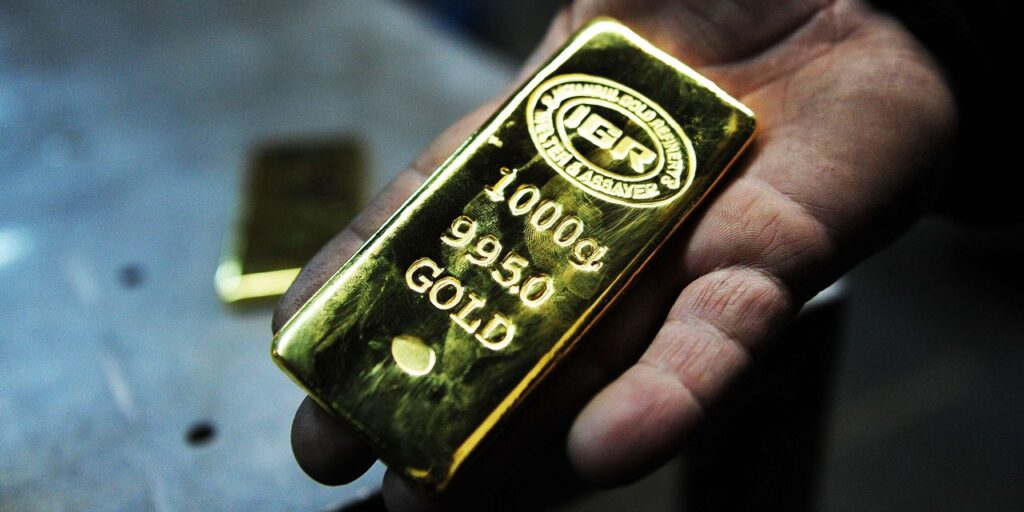Gold futures ended lower on Friday as a much stronger-than-expected U.S. May employment report suggested that the Federal Reserve will need to do more to tame inflation.
Prices for the metal, however, held onto a gain of more than 1% for the week on the heels of three consecutive weekly declines.
Price action
-
Gold futures for August delivery
GC00,
-0.03% GCQ23,
-0.03%
fell $25.90, or 1.3%, to settle at $1,969.60 per ounce on Comex after settling on Thursday at the highest since mid-May. Prices based on the most-active contract posted a weekly rise of 1.3%, according to Dow Jones Market Data. -
Silver futures for July delivery
SI00,
+0.60% SIN23,
+0.60%
declined by 24 cents, or 1%, to $23.75 per ounce, settling 1.7% higher for the week. -
July platinum
PLN23,
+0.01%
fell $6.60, or nearly 0.7%, to $1,003.50 per ounce, with prices down 2.4% for the week. Palladium futures for September
PAU23,
-0.37%
gained $12.80, or 0.9%, to $1,403.50 per ounce, losing 1.4% for the week. -
Copper for July delivery
HGN24,
-0.13%
gained 2 cents, or 0.4%, to $3.73 per pound, up 1.2% for the week.
Market drivers
“Gold bulls’ shoulders slumped” after yet another red-hot headline nonfarm payrolls print that blew past estimates,” Han Tan, chief market analyst at Exinity Group, told MarketWatch. Still, despite the post-jobs data pullback in gold prices, the metal is still set to end a run of three straight weekly losses, he said.
The U.S. added 339,000 new jobs in May, the government reported on Friday. Wall Street had forecast a 190,000 increase in new jobs, based on the government’s survey of business establishments. Employment gains in April and March were also considerably higher than previously reported.
The “notable rise in May’s unemployment rate along with slowing earnings growth may cloud the outlook surrounding the Fed’s next moves,” said Tan. “This places a greater burden on the mid-June CPI print in potentially offering a stronger signal about the FOMC’s next decision, which should set gold’s near-term trajectory.”
Prices for gold had climbed “well north” of $2,000 an ounce in early May, buoyed by safe-haven demand, with concerns surrounding a possible U.S. debt default the primary impetus, said Jeff Klearman, portfolio manager at GraniteShares, which runs the GraniteShares Gold Trust
BAR,
Those concerns, “though ebbing and flowing, have receded,” moving gold prices off their recent highs.
Recent comments by Fed officials strongly suggesting the Fed will not raise rates in the upcoming June FOMC meeting have pushed Treasury yields and the U.S. dollar lower, allowing gold prices to move noticeably off their recent lows, he said.
Read: Fed’s Harker wants to ‘skip’ a rate hike in June
The Fed “pause” is significant beyond the fact the Fed funds target rate won’t move higher, at least immediately, but because the “pause” may imply the Fed is “uncertain regarding the cumulative effect of its previous 10 rate increases and, maybe more importantly…concerned — at a minimum — about tightening credit conditions resulting from the turmoil in the regional banking system,” said Klearman.
So despite the strong employment report Friday, “gold prices remain resilient with limited declines,” he said. “This is likely due to the two underlying concerns mentioned above and perhaps to growing expectations these concerns may lead the Fed to ease later this year.”
Copper futures, meanwhile, posted a second straight session gain to settle at their highest since May 19, but looked to post the biggest quarterly percentage decline since the second quarter of last year.
Read: Dr. Copper’s weak performance suggests more economic woes ahead
Read the full article here













